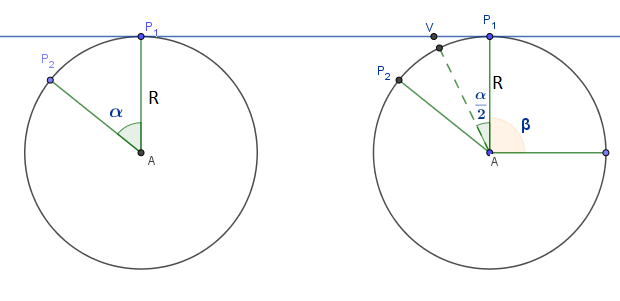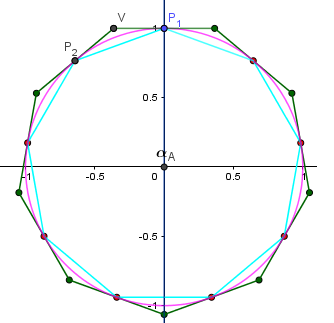Polygon Exterior Sequence Derivation
Here we will derive an n-gon that circumscribes a circle and where the first point can be at any defined angle around the circle. Let $P_{k}$ be the point on a circle that has a tangent segment as one of the sides of an exterior n-gon. The tangent segment (figure 2 shows these tangent line segments.) will only go half way to the next circle point. If $\alpha$ is the angle $P_{1}AP_{2}$ (see figure 1), then angle $P_{1}AV$ is $\alpha/2$. Of course $\alpha=2\pi/n$. Obvious because $2\pi$ is the distance around a circle and $n$ is the number of vertices. So, $$\frac{\alpha}{2}=\frac{\pi}{n}=\frac{1}{2}\cdot\frac{2\pi}{n}.$$ Let $\mathbf{\hat{u}}$ be the unit vector pointing at $V$. $$\mathbf{\hat{u}}=\frac{\left(\cos\left(\frac{\alpha}{2}+\beta\right),\sin\left(\frac{\alpha}{2}+\beta\right)\right)}{\Vert\left(\cos\left(\frac{\alpha}{2}+\beta\right),\sin\left(\frac{\alpha}{2}+\beta\right)\right)\Vert}$$

In order to find point $V$ we can take advantage of the right triangle, $P_{1}AV$ $($with the right angle at $P_{1}).$ The tangent segment, $\overline{P_{1}V}$ is the opposite leg of angle $\alpha/2$. Therefore, $$\tan\left(\frac{\alpha}{2}\right)=\frac{(\overline{P_{1}V})}{R}$$ and $$\overline{P_{1}V}=R\cdot\tan\left(\frac{\alpha}{2}\right).$$ If we let $h=\text{line }\overline{AV}$, then by Pythagoras $h=\sqrt{\left(R\cdot\tan\left(\frac{\alpha}{2}\right)\right)^{2}+R^{2}}$ and $V=h\cdot\mathbf{\hat{u}}.$
So let's work out a second point $V$, call it $V_{2}$. It will be halfway between points $P_{2}$ and $P_{3}$ and its direction angle will be $$\text{Angle to V_2} \Longrightarrow (\alpha+\frac{\alpha}{2}+\beta) \tag{EQ1} \label{EQ1}.$$ Extrapolating from table [tab:n-gon Derivation], we can write its direction vector. $$\mathbf{\hat{u}_{2}}=\frac{\left[\cos\left((k-1)\alpha+\frac{\alpha}{2}+\beta\right),\sin\left((k-1)\alpha+\frac{\alpha}{2}+\beta\right)\right]}{\left\Vert \left[\cos\left((k-1)\alpha+\frac{\alpha}{2}+\beta\right),\sin\left((k-1)\alpha+\frac{\alpha}{2}+\beta\right)\right]\right\Vert } \tag{EQ2} \label{EQ2}$$ $$V_{k}=h\cdot\mathbf{\hat{u}_{2}},k=1,2\dots n$$
You can see that we rather quickly went from $V_{2}$ to all of the exterior $V_{k}$. If we want, since $\alpha$ is quite simple, we can substitute $\frac{2\pi}{n}$ for $\alpha$ and get it out of the equation. Substitute $\alpha=\frac{2\pi}{n}$ into $\bbox[darkblue]{\eqref{EQ1}}.$ and apply the point counter $(k-1)$ to get $$\text{Angle to}V_k=(k-1)\frac{2\pi}{n}+\frac{2\pi/n}{2}+\beta=(k-1)\frac{2\pi}{n}+\frac{\pi}{n}+\beta$$ then $$\mathbf{\hat{u}_{k}}=\frac{\left[\cos\left((k-1)\frac{2\pi}{n}+\frac{\pi}{n}+\beta\right),\sin\left((k-1)\frac{2\pi}{n}+\frac{\pi}{n}+\beta\right)\right]}{\left\Vert \left[\cos\left((k-1)\frac{2\pi}{n}+\frac{\pi}{n}+\beta\right),\sin\left((k-1)\frac{2\pi}{n}+\frac{\pi}{n}+\beta\right)\right]\right\Vert }$$ $$V_{k}=h\mathbf{\hat{u}_{k}},k=1,2,\dots,n \tag{EQ3} \label{EQ3}$$
